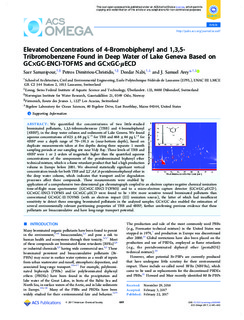| dc.contributor.author | Samanipour, Saer | |
| dc.contributor.author | Dimitriou-Christidis, Petros | |
| dc.contributor.author | Nabi, Deedar | |
| dc.contributor.author | Arey, J. Samuel | |
| dc.date.accessioned | 2018-04-13T10:33:33Z | |
| dc.date.available | 2018-04-13T10:33:33Z | |
| dc.date.created | 2017-02-23T09:06:04Z | |
| dc.date.issued | 2017 | |
| dc.identifier.citation | ACS Omega. 2017, 2 (2), 641-652 . | nb_NO |
| dc.identifier.issn | 2470-1343 | |
| dc.identifier.uri | http://hdl.handle.net/11250/2494052 | |
| dc.description | This is an open access article published by American Chemical Society in ACS Omega, available online: https://pubs.acs.org/ | |
| dc.description.abstract | We quantified the concentrations of two little-studied brominated pollutants, 1,3,5-tribromobenzene (TBB) and 4-bromobiphenyl (4BBP), in the deep water column and sediments of Lake Geneva. We found aqueous concentrations of 625 ± 68 pg L−1 for TBB and 668 ± 86 pg L−1 for 4BBP over a depth range of 70−191.5 m (near-bottom depth), based on duplicate measurements taken at five depths during three separate 1 month sampling periods at our sampling site near Vidy Bay. These levels of TBB and 4BBP were 1 or 2 orders of magnitude higher than the quantified aqueous concentrations of the components of the pentabrominated biphenyl ether technical mixture, which is a flame retardant product that had a high production volume in Europe before 2001. We observed statistically significant vertical concentration trends for both TBB and 2,2′,4,4′,6-pentabromobiphenyl ether in the deep water column, which indicates that transport and/or degradation processes affect these compounds. These measurements were enabled by application of a comprehensive two-dimensional gas chromatograph coupled to an electron capture negative chemical ionization time-of-flight mass spectrometer (GC×GC-ENCI-TOFMS) and to a micro-electron capture detector (GC×GC-μECD). GC×GC-ENCI-TOFMS and GC×GC-μECD were found to be >10× more sensitive toward brominated pollutants than conventional GC×GC-EI-TOFMS (with an electron impact (EI) ionization source), the latter of which had insufficient sensitivity to detect these emerging brominated pollutants in the analyzed samples. GC×GC also enabled the estimation of several environmentally relevant partitioning properties of TBB and 4BBP, further confirming previous evidence that these pollutants are bioaccumulative and have long-range transport potential. | nb_NO |
| dc.language.iso | eng | nb_NO |
| dc.publisher | American Chemical Society | nb_NO |
| dc.title | Elevated Concentrations of 4-Bromobiphenyl and 1,3,5-Tribromobenzene Found in Deep Water of Lake Geneva Based on GC×GC-ENCI-TOFMS and GC×GC-μECD | nb_NO |
| dc.type | Journal article | nb_NO |
| dc.type | Peer reviewed | nb_NO |
| dc.description.version | publishedVersion | nb_NO |
| dc.rights.holder | This is an open access article published under an ACS AuthorChoice License, which permits copying and redistribution of the article or any adaptations for non-commercial purposes. © 2017 American Chemical Society | nb_NO |
| dc.source.pagenumber | 641-652 | nb_NO |
| dc.source.volume | 2 | nb_NO |
| dc.source.journal | ACS Omega | nb_NO |
| dc.source.issue | 2 | nb_NO |
| dc.identifier.doi | 10.1021/acsomega.6b00440 | |
| dc.identifier.cristin | 1453296 | |
| dc.relation.project | Swiss NSF R’Equip grant: 206021-128753 | nb_NO |
| dc.relation.project | Fondation pour l’Etude des Eaux du Léman | nb_NO |
| cristin.unitcode | 7464,30,21,0 | |
| cristin.unitname | Miljøkjemi | |
| cristin.ispublished | false | |
| cristin.fulltext | preprint | |
